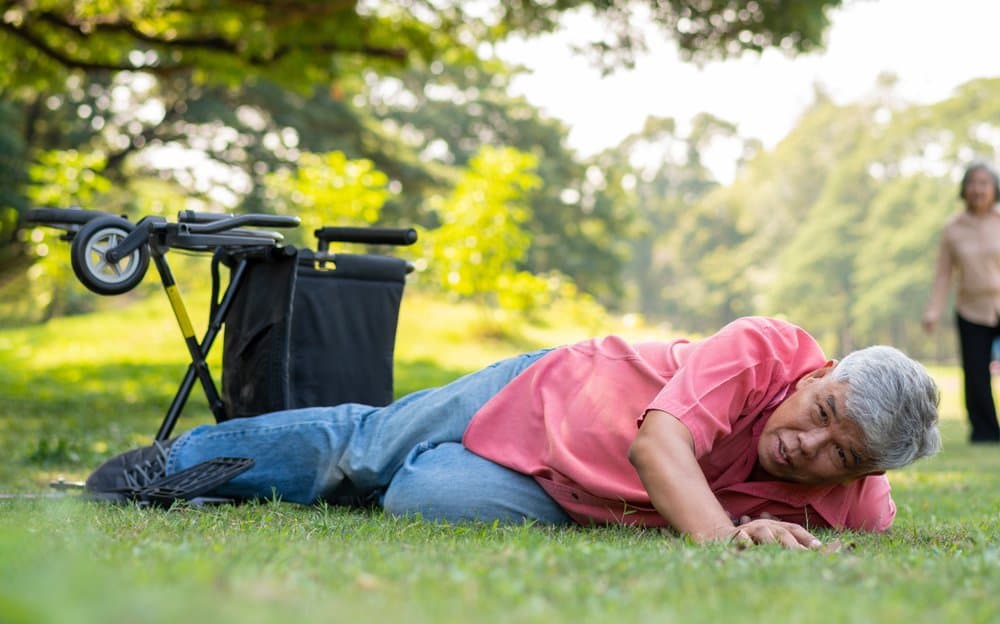
After imbibing his usual pre-dinner cocktails, the patient, a 69-year-old retired executive, decided to go and check his mailbox. As he approached the mailbox, he missed the step off the curb and lost his balance, falling forward and striking his head on the road. He lay there for a few seconds, not quite sure of what had happened, then got up and made his way back to his home.
When he entered his house he was bleeding profusely from a wound on his forehead. His wife immediately called EMS against his wishes as he was quite embarrassed.
On arrival of EMS, the bleeding from the wound on his forehead was still brisk but was controllable with direct pressure. His speech was slightly slurred and his initial ABCs were unremarkable. Vitals were HR 100, BP 120/76, and RR of 18.
He denied neck pain but did complain of a severe headache. There was no battle sign or raccoon eyes. His neck was non-tender and there were no step-offs at the c-spine.
The patient’s history was also positive for atrial fibrillation, for which he was taking Coumadin.
The patient was placed in a c-collar and backboarded. The EMTs correctly decided they could not rule out c-spine injury given his distracting head pain, alcohol intoxication, and his age.
Older patients are generally at higher risk for c-spine injuries in trauma from a standing height.
Ideally, this patient should have been transported to a level one trauma center due to his age, signs, symptoms and his history of anticoagulation; however, due to geographical constraints, he was taken to the local level IV trauma hospital for initial evaluation.
There is no exact definition of geriatric – it is more than just an age, although we often use age to define it. The fact is that people in their sixties can be more robust and healthier than people in their 50s, depending on genetics and lifestyle choices. Generally, people the age of 65 or older are considered geriatric because that is the age of qualification for Medicare and a common retirement age; however, the frailty at that age is quite variable.
The only certainty is that with every advancing decade people age and become more frail. A fall, even out of bed, can result in significant injury. Also, there are challenges to assessment such as a blunted response to blood loss and sometimes cognitive decline which has resulted in the undertriage of elderly trauma patients. The American College of Surgeons recommends transport to a trauma center for trauma patients over the age of 55.
Aging impacts both our assessment and treatment decisions. Concerning head injuries, older patients are at higher risk for intracranial bleeding and subdural hematomas. Many have no initial neurological deficits. This higher risk for bleeding is due to the shrinking of the brain (about 5% per decade after age 40) and the more fragile bridging vessels between the brain and the dura.
The smaller brain moves around more in trauma in an elderly person, and these fragile vessels are more vulnerable to tearing resulting in subdural bleeds. Also, a higher percentage of older people are taking blood thinners or antiplatelet medication.
A CT scan showed this patient sustained a subdural hematoma which required surgery. CT of his C-spine, fortunately, showed no acute injury. His c-spine precautions were discontinued and he was transferred to a level one trauma center for definitive care.
When he entered his house he was bleeding profusely from a wound on his forehead. His wife immediately called EMS against his wishes as he was quite embarrassed.
On arrival of EMS, the bleeding from the wound on his forehead was still brisk but was controllable with direct pressure. His speech was slightly slurred and his initial ABCs were unremarkable. Vitals were HR 100, BP 120/76, and RR of 18.
He denied neck pain but did complain of a severe headache. There was no battle sign or raccoon eyes. His neck was non-tender and there were no step-offs at the c-spine.
The patient’s history was also positive for atrial fibrillation, for which he was taking Coumadin.
The patient was placed in a c-collar and backboarded. The EMTs correctly decided they could not rule out c-spine injury given his distracting head pain, alcohol intoxication, and his age.
Older patients are generally at higher risk for c-spine injuries in trauma from a standing height.
Ideally, this patient should have been transported to a level one trauma center due to his age, signs, symptoms and his history of anticoagulation; however, due to geographical constraints, he was taken to the local level IV trauma hospital for initial evaluation.
There is no exact definition of geriatric – it is more than just an age, although we often use age to define it. The fact is that people in their sixties can be more robust and healthier than people in their 50s, depending on genetics and lifestyle choices. Generally, people the age of 65 or older are considered geriatric because that is the age of qualification for Medicare and a common retirement age; however, the frailty at that age is quite variable.
The only certainty is that with every advancing decade people age and become more frail. A fall, even out of bed, can result in significant injury. Also, there are challenges to assessment such as a blunted response to blood loss and sometimes cognitive decline which has resulted in the undertriage of elderly trauma patients. The American College of Surgeons recommends transport to a trauma center for trauma patients over the age of 55.
Aging impacts both our assessment and treatment decisions. Concerning head injuries, older patients are at higher risk for intracranial bleeding and subdural hematomas. Many have no initial neurological deficits. This higher risk for bleeding is due to the shrinking of the brain (about 5% per decade after age 40) and the more fragile bridging vessels between the brain and the dura.
The smaller brain moves around more in trauma in an elderly person, and these fragile vessels are more vulnerable to tearing resulting in subdural bleeds. Also, a higher percentage of older people are taking blood thinners or antiplatelet medication.
A CT scan showed this patient sustained a subdural hematoma which required surgery. CT of his C-spine, fortunately, showed no acute injury. His c-spine precautions were discontinued and he was transferred to a level one trauma center for definitive care.


